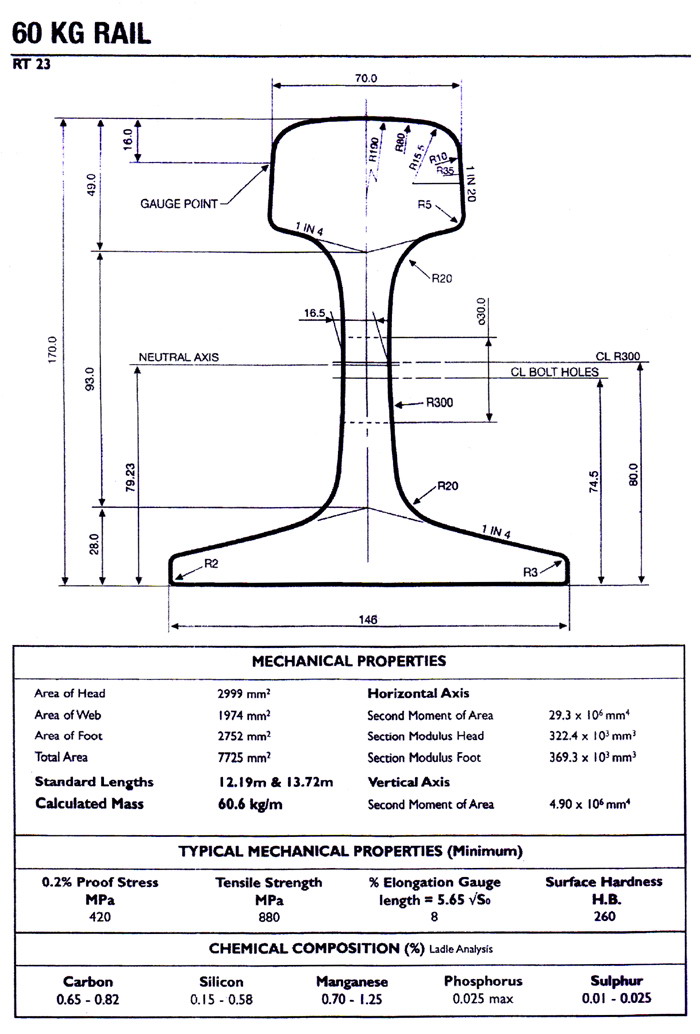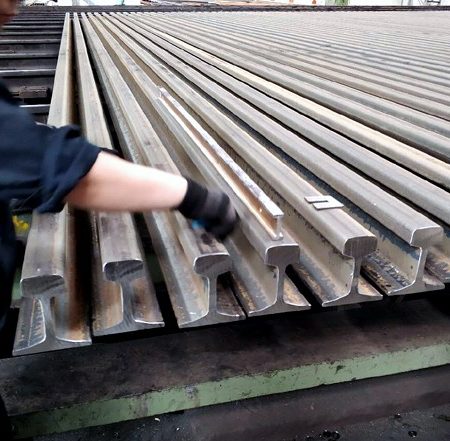Australian standard 60kg/m steel rail is typically used in heavy rail applications, such as mainline and freight rail tracks. The rail has a head width of 70mm, a head height of 49mm, a foot width of 146mm, and a foot height of 28mm. This type of rail is designed to withstand heavy loads and high speeds and is commonly used in Australia’s rail network.

The correct dimensions for Australian standard 60kg/m steel rail are as follows:
– Lebar Kepala: 70Mm
– Ketinggian Kepala: 49Mm
– Foot Width: 146Mm
– Foot Height: 28Mm
– Overall Length: 16.5m
The rail weighs 60kg per meter and is commonly used in heavy rail applications in Australia for both passenger and freight services.
SEBAGAI 1085.1-2002 60 Kg Rail adalah kategori rel tertentu yang mematuhi piawaian ini. Ia merujuk kepada sejenis rel yang beratnya 60 kilogram per meter dan memenuhi keperluan untuk kimpalan flash butt seperti yang ditakrifkan dalam AS 1085.1-2002. Kereta api jenis ini biasanya digunakan dalam pembinaan dan penyelenggaraan kereta api di Australia.
Kereta api AS60 adalah sejenis rel keluli yang biasa digunakan untuk pembinaan landasan kereta api. Ia mempunyai panjang standard 25 meter dan berat sekitar 60 kilogram per meter. The AS60 rail is mainly used for heavy-haul railway lines that are designed to carry high loads over long distances. Its usage is well-suited to heavy-duty freight transport and is capable of handling heavy locomotives and large cargo loads.
The installation of AS60 rail typically involves several steps, termasuk yang berikut:
1. Penyediaan tapak: The first step is to prepare the site for railway track construction. This involves clearing the land, leveling the ground, and laying a foundation of ballast.
2. Penjajaran: The AS60 rails should be aligned correctly and positioned according to the design specifications. This step also includes ensuring that the rails are evenly spaced and straight.
3. Rail fastening: The rails should be firmly fastened to the sleepers or ties using clips or other fastening methods. This ensures that the rails remain in place over time and maintain their correct position.
4. Kimpalan: Sekiranya perlu, welding is done to join the rails together. This step is important to ensure that there are no gaps or misalignments between the rails, which would cause problems for trains traveling over them.
5. Finishing touches: Once the rails are secured in place, the final touches are added, such as adding ballast between the sleepers to hold the rails firmly in place and providing drainage to prevent water from accumulating.
As installation of railway tracks can be complex and requires specialized knowledge and tools, it is often best carried out by experienced professionals in rail construction.
Transporting an AS60 rail can be a complex task due to its size and weight. Here are some general steps for transporting an AS60 rail:
1. Obtain the necessary permits and permissions to transport the rail. This may involve obtaining permits from local authorities, obtaining clearance from utility companies, and obtaining special permits for oversized loads.
2. Choose a suitable mode of transportation. Depending on the distance, terrain, and infrastructure, the rail can be transported by truck, train, or barge.
3. Prepare the rail for transportation. This may involve cutting the rail into shorter sections, bundling the sections together, and securing them to a flatbed trailer or railcar.
4. Load the rail onto the selected transportation vehicle using heavy equipment such as a crane.
5. Secure the rail to prevent it from shifting during transport.
6. Transport the rail to its destination, following all safety regulations and traffic laws.
7. Unload the rail using appropriate heavy equipment and place it in its final location.
Please note that transporting an AS60 rail can be a specialized task that requires careful planning and execution. It may be helpful to consult with a transportation expert or railway specialist to ensure that the rail is transported safely and efficiently.
Kami boleh membekalkan rel bawah rata standard antarabangsa seperti di bawah, jika anda memerlukannya, sila berasa bebas untuk bertanya kepada kami:





